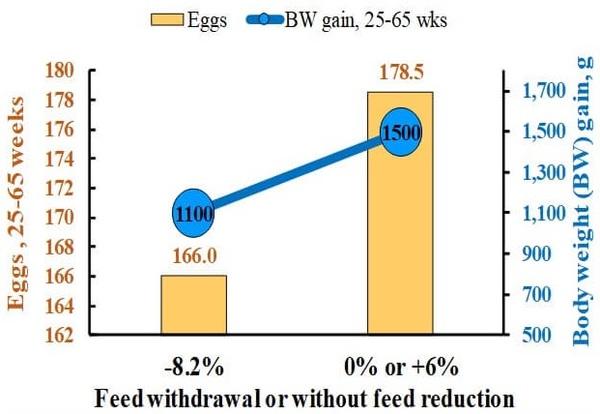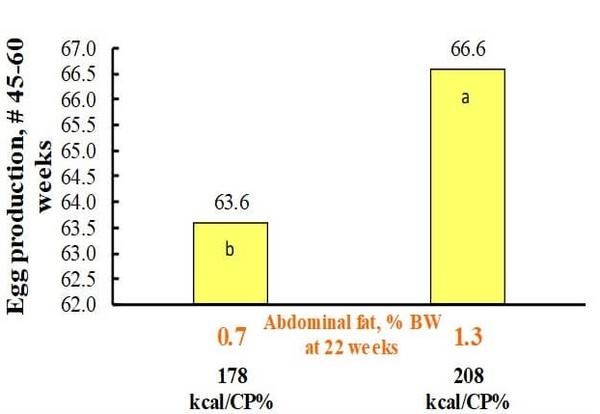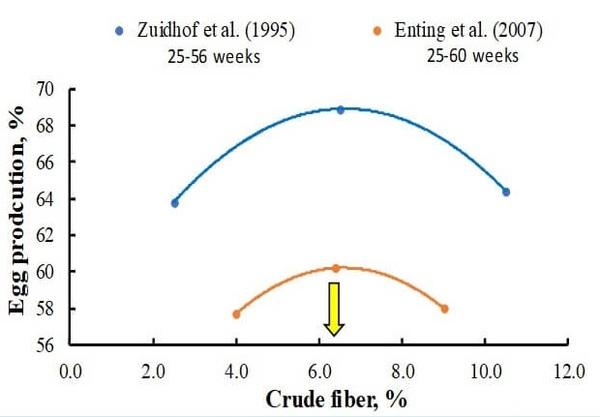Some breeder flocks have higher egg peak production, 92%, whereas other breeder flocks reach 82% at egg peak. On the other hand, some broiler breeders lay a good peak egg production, but as hens age, egg production descends more than expected. In this situation, how can we increase the persistence of egg production in broiler breeders? Breeder managers should evaluate the following four points for improving the persistence of egg production: (a) body weight uniformity and peak egg production, (b) feed withdrawal in lay, (c) body composition at rearing and lay periods, and (d) dietary fiber.
a) Body weight uniformity and peak egg production
Bodyweight grading for broiler breeders, from an earlier age, is the most important technique to achieve high peak eggs and egg persistence. The more bodyweight grading the best egg production per hen house. Either grading the bodyweight manually or mechanically produces the highest output as compared to non-grading flocks. Another way to enhance the bodyweight uniformity is by feeding more dietary fiber during rearing, but this is not sufficient as a single tool. Successful bodyweight grading starts at 1, 4, 8, 12, and 16 weeks of age, and each age group divided from 4 to 6 weight groups or more. Of course, this bodyweight grading demands more labor; nevertheless, the surplus of chicks pay off those labor costs.
Grading bodyweight reduces intrinsical bird weight variability. For example, grouping in similar weights the flock and feeding according to their average body weight will avoid small and large birds in production. Herein, the slight bird group eats more feed while the large bird group consumes less feed. From both bird groups, managers should focus on the lightweight group more because this group will impact egg production negatively. For instance, observing those bird groups personally how evenly they are eating and ideally almost at the same time to consume the same quantity of feed per bird. Immediately after eating, evaluating crop fullness will indicate how the hens ate evenly.
Checking the feeding clean-up time, providing adequate feeder space per bird, and always turning on the water before eating helps for keeping the flocks healthy and uniform. Besides, birds gradually and slowly approaching the feeders by dimming the lights will result in better uniformity and avoiding unexpected deaths due to piling. After good bodyweight grading and feed allocation management, hens with low coefficient of variation as 4-6%, or bodyweight uniformity over 90% at +/- 10%, will lay peak eggs over 90% (Figure 1). Because the muscle is the main pool of amino acids for egg protein, the variability of the breast conformation might fine-tune more the relationship between peak egg production and breast meat uniformity. Tools that quantify the degree of angular breast meat in vivo in every grading will add more information for decreasing future breast meat variation.
Figure 1. Relationship between bodyweight uniformity and peak egg production.
b) Feed withdrawal post peak feed
Nowadays, broiler breeders need limited feed withdrawal post-peak feed during lay as compared to previous years. The continued selection for growth and meat characteristics at a young bird’s age has produced a constant muscle growth rate during the lay production. Therefore, any reduction in muscle growth rate will affect the egg production due to the constant flow of amino acids from the muscle into the egg. A research study revealed that as hens age, the amino acids of albumen are more dependent on the amino acid muscle pool rather than the dietary amino acids (Ekmay et al. 2014). Thereby, if the bodyweight drops by reducing the feed intake, hens will diminish the egg productions as grew older.
Currently, the broiler breeders are fed in lay to target mostly the feed intake or energy intake instead of following a bodyweight profile. Thus, feed withdrawal values are between 0 to -5%. In contrast, flocks with -10% of feed withdrawal might control the body and egg overweight, but as hen ages will lay fewer eggs and also drop the fertility. As an example, if hens eat 165 grams at 28 weeks and 152 grams at 65 weeks, the feed withdrawal is -5%. Moreover, slower feed withdrawal from -26% to -13% yielded a better egg production (Lien and Hess, 2009). Even more, broiler breeders with no feed reduction post-peak laid more eggs and gained more body weight gain as compared to a feed withdrawal of -8.2% (Figure 2; Nirun, 2005). In both studies, the hens with better egg production gained more body weight gain.
Figure 2. With or without feed withdrawal on egg production and body weight gain.
Note: The values of treatments with 0% or +6% are averages for a range from 175 to 182 eggs, and from 1400 to 1600 grams approximately of body weight gain.
c) Body composition at rearing and lay periods
Adequate body composition during the rearing period will generate more eggs for the last weeks of production. Breeders observe this positive carryover effect when the abdominal fat is at 20 or 22 weeks of age. At the same time, these pullets at moving deposit lessened breast meat resulted from the higher dietary energy to amino acid ratios. Commercial flocks and research studies reported that broiler breeder hens with 1% of abdominal fat at 20 weeks, or 1.2% at 22 weeks as minimum values, enhanced the eggs by 3 to 5. According to this, van Emous et al. (2015) demonstrated that Ross 308 pullets fed more energy per protein promoted the eggs in the late phase (Figure 3).
Other lines show a similar pattern, but the total fat pad is dependent on the breeder lines. Further, farmer managers should monitor and evaluate the variation of abdominal fat during the rearing period, because the fat pad changes as birds age and for several reasons. For instance, heat stress conditions augment the fat pad; contrarily, diets with more fiber decline the abdominal fat. Moreover, the fat pad variation is also observed not only during the rearing period but also in the lay period, even with more intensity. In this regard, the measurements of abdominal fat and angular breast meat are crucial to successfully achieve higher egg persistence according to their commercial breeder conditions.
As hen ages, the fat and protein from the eggs rely more upon the fat and protein body reserves (Ekmay et al. 2014; Salas et al. 2017). In other words, the fat and protein body reserves should keep positive as hens grew older for the transfer of these nutrients into eggs. There is an inverse correlation between fat and protein body composition. Thereby, the higher fat pad means smaller muscle weight, and consequently less amino acids into the eggs, reducing the egg weight while increasing the numbers of eggs. To observe this effect, the hens should start with controlled muscle overweight from the starting point of lay; however, if hens are already overweight or over-fleshing during the lay, the sudden drop of weights will decline the egg production. Besides the lesser muscle weight from the beginning of lay, a constant muscle growth rate will also stimulate the late egg production.
Figure 3. Dietary protein to energy ratios in the rearing period on egg persistence.
Note: BW = body weight; energy and protein ratio from 2 to 22 weeks.
d) Dietary fiber
In the rearing, the higher fat pad yields better egg persistence, whereas, in the lay period, the gained fat pad does not result in better late egg production. In particular, hens fed more fiber reduced the abdominal fat and boosted the egg production and fertility at late periods (Mohiti-Asli et al. 2012). Indeed, in commercial flocks and pen studies observed that hens fed more dietary fiber improved egg production (Figure 4). In commercial flocks, the inclusion of more crude fiber created minor muscle overgrowth due to smaller whole-body overweight; despite, hens depleted the abdominal fat. In agreement with this finding, breeder pullets fed 11.5% of crude fiber, as compared to 6.9% of fiber, deposited slighter muscle breast during the rearing period (Bolaños, 2018).
Figure 4. Dietary fiber and egg production.
It seems that hens when feeding more fiber control better the muscle overgrowth, consequently avoiding egg overweight and increasing the number of eggs. How as hens age with limited muscle overgrowth rate will lay more eggs? Two factors may cause this positive effect. First, the longer digesta retention in the gastrointestinal tract due to fiber might supply nutrients into the eggs during the day more efficiently. Second, the shortened amino acids deposited in the muscle might avoid overflow of amino acids into the eggs, packing more eggs with controlled weight.
Usually, diets based on corn and soybean meal contain about 2.5-3.0% of crude fiber; hence, hen diets might increase the dietary crude up to 6.0%. Though, the soluble fiber should be restricted up to 3.5% because higher values decreased egg production (Enting et al. 2007). Thus, in practical terms feeding in terms of crude fiber and controlling the soluble fiber, the insoluble fiber or benefic fiber is managed indirectly. Moreover, when hens fed more fiber, the poultry managers should adjust the feed intake to feed similar energy allocations. At the same time, hens feeding more fiber will show satiety and drink minus water, producing fewer dirty eggs and footpad dermatitis and observing better cloaca feces quality.
Conclusions:
- Higher bodyweight uniformity in the rearing period will boost the peak egg production and egg persistence. Measurement of angular breast meats is another suitable option for bird grading.
- Feed withdrawal is overtime lower compared to previous years, even for some breeders no need for feed reduction and will display higher egg persistence.
- The higher the fat pad at moving age, the better the egg persistence, but in the lay period, the fat pad is not a good indicator due to its high variability. In contrast, avoiding muscle overgrowth but always a continued meat gain from the start point of lay stimulates egg production as hen ages.
- Feeding more dietary crude fiber in rearing and lay produces more eggs by controlling the muscle overweight mainly. Breeders might eat feeds with crude fiber levels up to 12% in the rearing perid and up to 6% in the lay period.
Conflict of Interest and disclaimer
The author declares that this article was conducted in the absence of any commercial or financial relationships that could be construed as a potential conflict of interest. Every attempt has been made to ensure that the material in this article is accurate, true, correct, and relevant at the time of writing. However, the author accepts no liability for any omissions, damage, loss, or financial consequences of using this article.
















.jpg&w=3840&q=75)